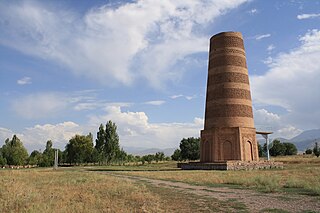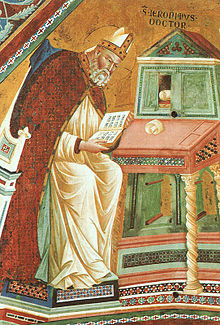The Kara-Khanid Khanate, also known as the Karakhanids, Qarakhanids, Ilek Khanids or the Afrasiabids, was a Karluk Turkic khanate that ruled Central Asia from the 9th to the early 13th century. The dynastic names of Karakhanids and Ilek Khanids refer to royal titles with Kara Khagan being the most important Turkic title up until the end of the dynasty.

Balasagun was an ancient Sogdian city in modern-day Kyrgyzstan, located in the Chüy Valley between Bishkek and the Issyk-Kul lake. Located along the Silk Road, the ruins of the city were inscribed in 2014 on the UNESCO World Heritage List as part of the Silk Roads: the Routes Network of Chang'an-Tianshan Corridor World Heritage Site.

The Pax Mongolica, less often known as Pax Tatarica, is a historiographical term modeled after the original phrase Pax Romana which describes the stabilizing effects of the conquests of the Mongol Empire on the social, cultural and economic life of the inhabitants of the vast Eurasian territory that the Mongols conquered in the 13th and 14th centuries. The term is used to describe the eased communication and commerce the unified administration helped to create and the period of relative peace that followed the Mongols' vast and violent conquests.

Damask is a woven, reversible patterned fabric. Damasks are woven by periodically reversing the action of the warp and weft threads. The pattern is most commonly created with a warp-faced satin weave and the ground with a weft-faced or sateen weave. Yarns used to create damasks include silk, wool, linen, cotton, and synthetic fibers, but damask is best shown in cotton and linen. Over time, damask has become a broader term for woven fabrics with a reversible pattern, not just silks.

Drogön Chogyal Phagpa, was the fifth leader of the Sakya school of Tibetan Buddhism. He was also the first Imperial Preceptor of the Yuan dynasty and was concurrently named the director of the Bureau of Buddhist and Tibetan Affairs, serving during the reign of Kublai Khan.

The Phagspa, ʼPhags-pa or ḥPʻags-pa script is an alphabet designed by the Tibetan monk and State Preceptor Drogön Chögyal Phagpa (1235–1280) for Kublai Khan, the founder of the Yuan dynasty (1271–1368) in China, as a unified script for the written languages within the Yuan. The actual use of this script was limited to about a hundred years during the Mongol-led Yuan dynasty, and it fell out of use with the advent of the Ming dynasty.

The Basilica of Saint Francis of Assisi is the mother church of the Roman Catholic Order of Friars Minor Conventual in Assisi, a town in the Umbria region in central Italy, where Saint Francis was born and died. It is a papal minor basilica and one of the most important places of Christian pilgrimage in Italy. With its accompanying friary, Sacro Convento, the basilica is a distinctive landmark to those approaching Assisi. It has been a UNESCO World Heritage Site since 2000.

Cloth of gold or gold cloth is a fabric woven with a gold-wrapped or spun weft—referred to as "a spirally spun gold strip". In most cases, the core yarn is silk, wrapped (filé) with a band or strip of high content gold. In rarer instances, fine linen and wool have been used as the core.

The Adoration of the Magi is a painting by the Italian painter Gentile da Fabriano. The work, housed in the Uffizi Gallery in Florence, Italy, is considered his finest work, and has been described as "the culminating work of International Gothic painting".
Hangul (Korean: 한글) is the native script of Korea. It was created in the mid fifteenth century by King Sejong, as both a complement and an alternative to the logographic Sino-Korean Hanja. Initially denounced by the educated class as eonmun, it only became the primary Korean script following independence from Japan in the mid-20th century.

Samite was a luxurious and heavy silk fabric worn in the Middle Ages, of a twill-type weave, often including gold or silver thread. The word was derived from Old French samit, from medieval Latin samitum, examitum deriving from the Byzantine Greek ἑξάμιτον hexamiton "six threads", usually interpreted as indicating the use of six yarns in the warp. Samite is still used in ecclesiastical robes, vestments, ornamental fabrics, and interior decoration.

The Afrasiab murals, also called the Paintings of the Ambassadors, is a rare example of Sogdian art. It was discovered in 1965 when the local authorities decided to construct a road in the middle of Afrāsiāb mound, the old site of pre-Mongol Samarkand. It is now preserved in a special museum on the Afrāsiāb mound.

Pseudo-Kufic, or Kufesque, also sometimes pseudo-Arabic, is a style of decoration used during the Middle Ages and the Renaissance, consisting of imitations of the Arabic script, especially Kufic, made in a non-Arabic context: "Imitations of Arabic in European art are often described as pseudo-Kufic, borrowing the term for an Arabic script that emphasizes straight and angular strokes, and is most commonly used in Islamic architectural decoration". Pseudo-Kufic appears especially often in Renaissance art in depictions of people from the Holy Land, particularly the Virgin Mary. It is an example of Islamic influences on Western art.

Carpets of Middle-Eastern origin, either from Anatolia, Persia, Armenia, Levant, the Mamluk state of Egypt or Northern Africa, were used as decorative features in Western European paintings from the 14th century onwards. More depictions of Oriental carpets in Renaissance painting survive than actual carpets contemporary with these paintings. Few Middle-Eastern carpets produced before the 17th century remain, though the number of these known has increased in recent decades. Therefore, comparative art-historical research has from its onset in the late 19th century relied on carpets represented in datable European paintings.

Islamic influences on Western art refers to the stylistic and formal influence of Islamic art, defined as the artistic production of the territories ruled by Muslims from the 7th century onward, on European Christian art. Western European Christians interacted with Muslims in Europe, Africa, and the Middle East and formed a relationship based on shared ideas and artistic methods. Islamic art includes a wide variety of media including calligraphy, illustrated manuscripts, textiles, ceramics, metalwork, and glass, and because the Islamic world encompassed people of diverse religious backgrounds, artists and craftsmen were not always Muslim, and came from a wide variety of different backgrounds. Glass production, for example, remained a Jewish speciality throughout the period. Christian art in Islamic lands, such as that produced in Coptic Egypt or by Armenian communities in Iran, continued to develop under Islamic rulers.

A paiza or paizi or gerege was a tablet carried by Mongol officials and envoys to signify certain privileges and authority. They enabled Mongol nobles and officials to demand goods and services from civilian populations.
Old Mandarin or Early Mandarin was the speech of northern China during the Jurchen-ruled Jin dynasty and the Mongol-led Yuan dynasty. New genres of vernacular literature were based on this language, including verse, drama and story forms, such as the qu and sanqu.
Menggu Ziyun is a 14th-century rime dictionary of Old Mandarin Chinese as written in the 'Phags-pa script that was used during the Yuan dynasty (1271–1368). The only surviving examplar of this dictionary is an 18th-century manuscript copy that belonged to Stephen Wootton Bushell (1844–1908), and is now held at the British Library. As the only known example of a 'Phags-pa script dictionary of Chinese, it is important both as an aid for interpreting Yuan dynasty texts and inscriptions written in Chinese using the 'Phags-pa script, and as a source for the reconstructed pronunciation of Old Mandarin.

The Yuan dynasty was a Mongol-ruled Chinese dynasty which existed from 1271 to 1368. After the conquest of the Western Xia, Western Liao, and Jin dynasties they allowed for the continuation of locally minted copper currency, as well as allowing for the continued use of previously created and older forms of currency, while they immediately abolished the Jin dynasty's paper money as it suffered heavily from inflation due to the wars with the Mongols. After the conquest of the Song dynasty was completed, the Yuan dynasty started issuing their own copper coins largely based on older Jin dynasty models, though eventually the preferred Yuan currency became the Jiaochao and silver sycees, as coins would eventually fall largely into disuse. Although the Mongols at first preferred to have every banknote backed up by gold and silver, high government expenditures forced the Yuan to create fiat money in order to sustain government spending.
Chinese ornamental gold silk is a type of silk fabric which employs gold as ornamentation; Chinese ornamental gold silk originated in China and have a long history in China. Gold and silk were precious goods; the combination of both in textiles created one of the most valuable commodities. Several gold-ornamental techniques can be summarized as: gold foil, gold powder, and gold thread technique.































